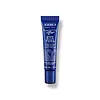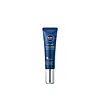What's inside
What's inside
 Key Ingredients
Key Ingredients

 Benefits
Benefits

 Concerns
Concerns

No concerns
 Ingredients Side-by-side
Ingredients Side-by-side

Water
Skin ConditioningDimethicone
EmollientGlycerin
HumectantNiacinamide
SmoothingMethyl Methacrylate Crosspolymer
Caffeine
Skin ConditioningEthylhexyl Palmitate
EmollientDimethicone/Vinyl Dimethicone Crosspolymer
Skin ConditioningDimethicone/PEG-10/15 Crosspolymer
PEG-10 Dimethicone
Skin ConditioningHydroxyethylpiperazine Ethane Sulfonic Acid
BufferingSodium Chloride
MaskingPerlite
AbsorbentPhenoxyethanol
PreservativeChlorphenesin
AntimicrobialSodium Citrate
BufferingP-Anisic Acid
MaskingTocopherol
AntioxidantDisodium EDTA
Ascorbyl Glucoside
AntioxidantAdenosine
Skin ConditioningGlycine Soja Protein
EmulsifyingDipropylene Glycol
HumectantCaprylyl Glycol
EmollientSodium Cocoyl Glutamate
CleansingChlorhexidine Digluconate
AntimicrobialN-Hydroxysuccinimide
Skin ConditioningPotassium Sorbate
PreservativeEthylhexylglycerin
Skin ConditioningSodium Benzoate
MaskingPalmitoyl Oligopeptide
CleansingChrysin
Skin ConditioningPalmitoyl Tetrapeptide-7
Skin ConditioningWater, Dimethicone, Glycerin, Niacinamide, Methyl Methacrylate Crosspolymer, Caffeine, Ethylhexyl Palmitate, Dimethicone/Vinyl Dimethicone Crosspolymer, Dimethicone/PEG-10/15 Crosspolymer, PEG-10 Dimethicone, Hydroxyethylpiperazine Ethane Sulfonic Acid, Sodium Chloride, Perlite, Phenoxyethanol, Chlorphenesin, Sodium Citrate, P-Anisic Acid, Tocopherol, Disodium EDTA, Ascorbyl Glucoside, Adenosine, Glycine Soja Protein, Dipropylene Glycol, Caprylyl Glycol, Sodium Cocoyl Glutamate, Chlorhexidine Digluconate, N-Hydroxysuccinimide, Potassium Sorbate, Ethylhexylglycerin, Sodium Benzoate, Palmitoyl Oligopeptide, Chrysin, Palmitoyl Tetrapeptide-7
Water
Skin ConditioningGlycerin
HumectantMethylpropanediol
SolventBehenyl Alcohol
EmollientCaprylic/Capric Triglyceride
MaskingCetyl Alcohol
EmollientDistarch Phosphate
AbsorbentGlyceryl Stearate Citrate
EmollientStearyl Alcohol
EmollientDicaprylyl Ether
EmollientCocoglycerides
EmollientSodium Hyaluronate
HumectantTocopherol
AntioxidantXanthan Gum
EmulsifyingSodium Hydroxide
BufferingEthylhexylglycerin
Skin ConditioningCaprylyl Glycol
EmollientPhenoxyethanol
PreservativeWater, Glycerin, Methylpropanediol, Behenyl Alcohol, Caprylic/Capric Triglyceride, Cetyl Alcohol, Distarch Phosphate, Glyceryl Stearate Citrate, Stearyl Alcohol, Dicaprylyl Ether, Cocoglycerides, Sodium Hyaluronate, Tocopherol, Xanthan Gum, Sodium Hydroxide, Ethylhexylglycerin, Caprylyl Glycol, Phenoxyethanol
Ingredients Explained
These ingredients are found in both products.
Ingredients higher up in an ingredient list are typically present in a larger amount.
Caprylyl Glycol is a humectant and emollient, meaning it attracts and preserves moisture.
It is a common ingredient in many products, especially those designed to hydrate skin. The primary benefits are retaining moisture, skin softening, and promoting a healthy skin barrier.
Though Caprylyl Glycol is an alcohol derived from fatty acids, it is not the kind that can dry out skin.
This ingredient is also used as a preservative to extend the life of products. It has slight antimicrobial properties.
Learn more about Caprylyl GlycolEthylhexylglycerin (we can't pronounce this either) is commonly used as a preservative and skin softener. It is derived from glyceryl.
You might see Ethylhexylglycerin often paired with other preservatives such as phenoxyethanol. Ethylhexylglycerin has been found to increase the effectiveness of these other preservatives.
Glycerin is already naturally found in your skin. It helps moisturize and protect your skin.
A study from 2016 found glycerin to be more effective as a humectant than AHAs and hyaluronic acid.
As a humectant, it helps the skin stay hydrated by pulling moisture to your skin. The low molecular weight of glycerin allows it to pull moisture into the deeper layers of your skin.
Hydrated skin improves your skin barrier; Your skin barrier helps protect against irritants and bacteria.
Glycerin has also been found to have antimicrobial and antiviral properties. Due to these properties, glycerin is often used in wound and burn treatments.
In cosmetics, glycerin is usually derived from plants such as soybean or palm. However, it can also be sourced from animals, such as tallow or animal fat.
This ingredient is organic, colorless, odorless, and non-toxic.
Glycerin is the name for this ingredient in American English. British English uses Glycerol/Glycerine.
Learn more about GlycerinPhenoxyethanol is a preservative that has germicide, antimicrobial, and aromatic properties. Studies show that phenoxyethanol can prevent microbial growth. By itself, it has a scent that is similar to that of a rose.
It's often used in formulations along with Caprylyl Glycol to preserve the shelf life of products.
Tocopherol (also known as Vitamin E) is a common antioxidant used to help protect the skin from free-radicals and strengthen the skin barrier. It's also fat soluble - this means our skin is great at absorbing it.
Vitamin E also helps keep your natural skin lipids healthy. Your lipid skin barrier naturally consists of lipids, ceramides, and fatty acids. Vitamin E offers extra protection for your skin’s lipid barrier, keeping your skin healthy and nourished.
Another benefit is a bit of UV protection. Vitamin E helps reduce the damage caused by UVB rays. (It should not replace your sunscreen). Combining it with Vitamin C can decrease sunburned cells and hyperpigmentation after UV exposure.
You might have noticed Vitamin E + C often paired together. This is because it is great at stabilizing Vitamin C. Using the two together helps increase the effectiveness of both ingredients.
There are often claims that Vitamin E can reduce/prevent scarring, but these claims haven't been confirmed by scientific research.
Learn more about TocopherolWater. It's the most common cosmetic ingredient of all. You'll usually see it at the top of ingredient lists, meaning that it makes up the largest part of the product.
So why is it so popular? Water most often acts as a solvent - this means that it helps dissolve other ingredients into the formulation.
You'll also recognize water as that liquid we all need to stay alive. If you see this, drink a glass of water. Stay hydrated!
Learn more about Water